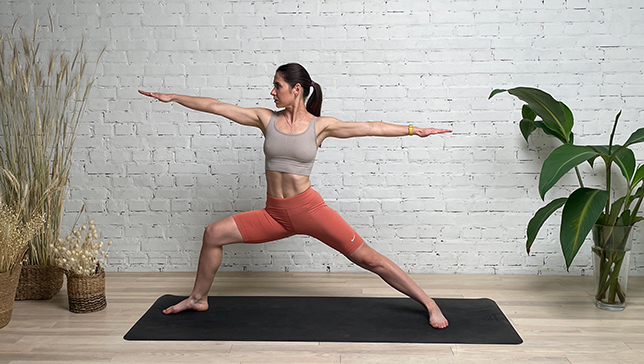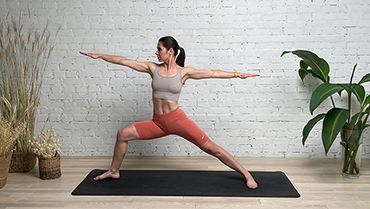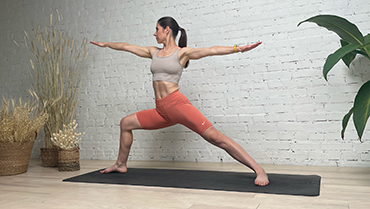Warrior Pose II - Virabhadrasana II

Contents
Warrior Pose II or Virabhadrasana II in Sanskrit, is a standing yoga pose that strengthens and stretches the legs, hips, and torso. As per Hindu Mythology, Virabhadra was the name of a Warrior created by Lord Shiva. Hence this pose comes from the creation of the fiercest warrior by Lord Shiva and so the name goes Virabhadrasana or Warrior Pose.
Virabhadrasana is considered a difficult pose as the body alignment needs to be accurate but is generally categorized as an intermediate or beginner-level pose. It is said that the power of this pose can be felt only if one is extremely flexible and stable with their body balance. Virabhadrasana II is one of the many variations of Virabhadrasana Pose.
Warrior II Yoga Pose is often incorporated into yoga sequences for its energizing and grounding effects, and can also be practiced on its own as a way to cultivate focus and mindfulness.
Pose Detail
- Difficulty: Beginners
- By Type: Hip Opening Yoga Poses, Strengthening Yoga Poses
- Body Position: Standing Yoga Poses
- By Benefit: Yoga Poses For Weight Loss
Step-by-Step Instructions
Benefits and Contraindications
Strengthens and stretches the legs and ankles
Therapeutic for carpal tunnel syndrome, flat feet, infertility, osteoporosis, and sciatica
Stretches the groins, chest and lungs, shoulders
Stimulates abdominal organs
Increases stamina
Relieves backaches, especially through second trimester of pregnancy
Diarrhea
High blood pressure
Neck problems: Don't turn your head to look over the front hand; continue to look straight ahead with both sides of the neck lengthened evenly.
Photo poses in different angles


Modifications And Props
There are several props that can be used to modify Virabhadrasana II, or Warrior II, yoga pose and make it more accessible, comfortable, or challenging depending on the practitioner’s needs and abilities. Here are some examples:
- Chair: Practicing Warrior II with a chair can provide additional support and stability, making it easier to maintain proper alignment and balance in the pose. The chair can be used to support the hands, torso, or hips, depending on the practitioner’s needs. This modification is helpful for those with limited mobility or balance.
- Wall: Practicing Warrior II with the back heel against a wall can help to improve alignment and balance, while also providing a gentle stretch for the calves and hamstrings. The wall can also be used to support the hands or arms, making the pose more challenging. This modification is helpful for those with limited balance or flexibility.
- Yoga Wheel: Place the yoga wheel on the ground, with the flat side facing up. Step the front foot onto the wheel, positioning it so that the ball of the foot is on the center of the wheel and the heel is off the edge. Step the back foot back, coming into a lunge position, with the back foot parallel to the back edge of the wheel. Align the front knee directly over the ankle, with the thigh parallel to the ground. Use the wheel for support and stability as needed. Lift the arms to shoulder height, parallel to the ground, and gaze over the front fingertips.
Useful Tips
- To prevent the front knee from collapsing inwards, wrap the muscles around the outer hip to externally rotate the leg.
- To prevent the ribs from flaring out, engage the core and draw the tailbone down towards the mat, which also keeps the lower back long.
Frequently Asked Questions
Warrior II works the quadriceps, hamstrings, glutes, calves, and core muscles. It also stretches the hips, groins, chest, and shoulders.
Yes, Warrior II can be practiced during pregnancy with proper modifications and guidance from a qualified yoga teacher or healthcare provider. Pregnant women should avoid deep lunges and twists, and should listen to their bodies and modify the pose as needed.
Common mistakes in Warrior II include letting the front knee collapse inward, leaning too far forward or backward, raising the shoulders towards the ears, and tensing the neck and jaw. Practitioners should focus on maintaining proper alignment and engaging the core and leg muscles to avoid these mistakes.
The duration of holding Warrior II can vary depending on the practitioner’s experience and goals. Generally, holding the pose for 5-10 deep breaths on each side is recommended to allow for sufficient stretching and strengthening of the muscles.
Modifications & Variations
- Warrior Pose II Back At Wall
- Warrior Pose II With Chair In Front
- Seated Warrior Pose II Wheel
- Warrior II Against Wall Block Under Foot
- One Legged Warrior II Pose Aerial
- Warrior Pose II Arms Chair
- Warrior Pose II Eagle Arms Variation Aqua
- Peaceful Warrior Pose
- Extended Side Angle Pose
- Bound Extended Side Angle